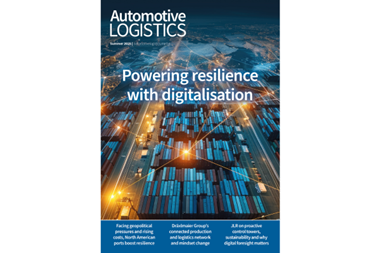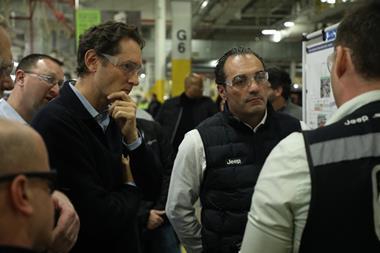 It may be at a similar level of development, but Canada is a different logistical landscape to the US, and its changing production patterns mean providers have to work harder to remain efficient
It may be at a similar level of development, but Canada is a different logistical landscape to the US, and its changing production patterns mean providers have to work harder to remain efficient
In this story...
Such geography has led to different behaviour among Canadian carmakers and logistics providers. For example, Canada’s plants and ports are even more dependent on rail logistics for moving vehicles than in the US or Mexico, with a high ratio of rail miles versus road. At Fiat Chrysler Automobiles, which is the country’s top-selling carmaker, 90% of the miles it ships its vehicles in Canada are by rail, compared to 10% by road, says Marc Brazeau, head of vehicle transportation. “FCA has a higher reliance in Canada on rail compared to the US due to the long transport distances involved,” he says.
Although some winters are harsher than others, climate is always a factor in Canada. For FCA, the past two winters in Canada have been particularly difficult, causing network disruptions and vehicle backlogs, which led to more dealer pickups and afterhours deliveries, says Brazeau. In March 2015, the port of Halifax was frozen, causing a backlog at its vehicle terminal and necessitating diversions to ports such as Davisville, Rhode Island and Baltimore, Maryland.
Canada has a strong set of logistics providers who are accustomed to these conditions. Its two class A railways, Canadian Pacific (CP) and Canadian National (CN), are major players in North America, not only in transport, but also vehicle yard and rail ramps, and for terminals at seaports. This past autumn, CP even launched several takeover bids for US railway Norfolk Southern, although the latter has so far rejected them on grounds that they undervalued the American company and that competition authorities in the US would have likely rejected the deal.
Canada also has a competitive market for road transport, including a mix of different size players and owner-operators, with considerable business moving between both sides of the US-Canada border. Carmakers in Canada contract with a variety of different players, including union and non-union carriers. Steve Istvanov, manager of customs and logistics at Kia Canada, for example, says the carmaker has recently been bringing on more non-unionised owner-operators to secure lower trucking prices.
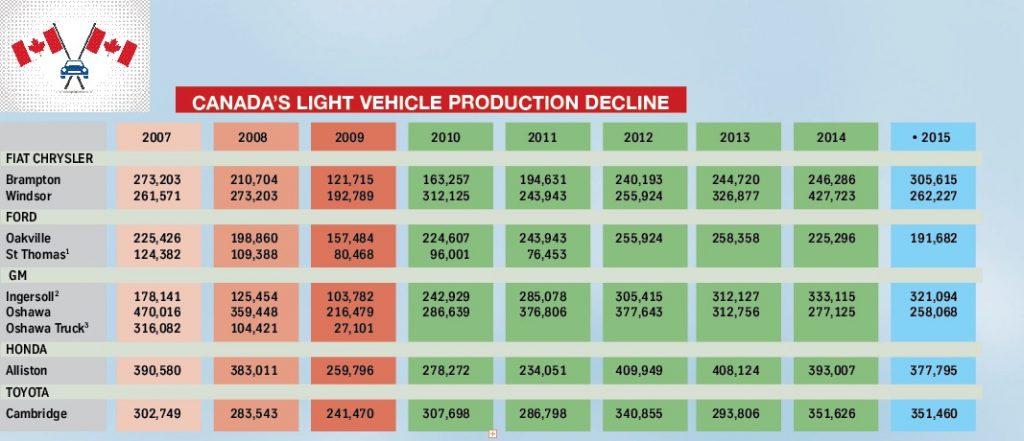
1. St Thomas – closed in 2011. 2. Ingersoll – was JV between GM/Suzuki until 2009. 3. Oshawa Truck – closed in 2010.
Canada source: Automotive News Data Center
US & Mexico source: PwC Autofacts
Another interesting distinction in Canada is that there is generally less resistance to co-loading different OEMs on the same transport equipment as there has traditionally been in the US. Mike Hansen, CEO at L. Hansen’s Forwarding, the country’s largest road carrier for vehicles, says his company has combined brands for many years. Hansen’s also partners with rail providers, including with CP, to move cars across the length and breadth of Canada.
Likewise, Canada’s low density population forces carriers to be more open to carrying other cargo types than they might need to be in the US. Brazeau says that FCA wants carriers with flexible fleets, including flatbeds and smaller trucks. It is perhaps no coincidence that the company pushing for fully flexible carrier equipment, Convertible Trailer Manufacturing (CTM), is from Canada. CTM’s founder, Bill Pawluk, first started using convertible equipment with his own car haulier business in Canada in the 1990s and 2000s.
While Canada is a dynamic market, it is in the midst of changes and restructuring that could have profound effects for vehicle logistics. While the US and Mexico are now building substantially more vehicles than they did prior to the 2008-2009 financial crisis, Canada has seen its output decline from around 2.6m light vehicles in 2005, to a total likely to slip below 2.1m units in 2015. The country has lost out on investment in production to the US and Mexico over the past five years, in part because of higher costs, as well as because of the strength of the Canadian dollar. The ‘loonie’, as it is called in Canada, reached record highs earlier this decade, trading at parity or stronger than the US dollar through much of 2011 and 2012 and hurting export profits. The currency has since depreciated, however analysts such as IHS and PwC Autofacts have forecasted that Canada’s vehicle assembly will fall further over the next few years.
Bill Garrett, president and chief executive officer at US-based logistics provider Vascor, which operates four yards in Canadian provinces and provides inspections at 18 sites for Ford and General Motors, points to a slower overall economic pace compared to the US, along with higher costs. For example, though the loonie’s fall against the dollar has been good for vehicle exports (in December it was trading at around C$1.33), it has increased local costs for logistics providers like Vascor, while also raising the price of US imports. Garrett also points to a much higher percentage of organised labour in Canada, which makes it more difficult for OEMs to contract labour agreements.
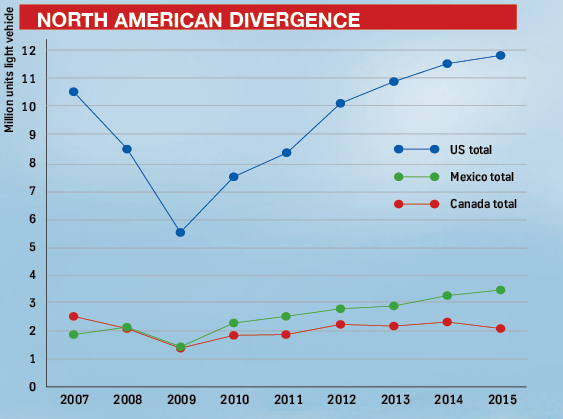 On the other hand, Canada’s vehicle market has shown strength, with sales at all-time highs following a period of relative stagnation. New vehicle sales were flat from 2005 through 2008, averaging 1.65m units per year, dropping to 1.48m in 2009 (a much more gentle decline than in the US that year). Since then, they have climbed steadily to a record 1.88m units in 2014; sales in 2015 were on pace to rise about 3% further to 1.93m. Nevertheless, this growth rate has not been as sharp as the recent rises in the US, as Canada, a large oil producer, has been hurt by the fall in commodity prices.
On the other hand, Canada’s vehicle market has shown strength, with sales at all-time highs following a period of relative stagnation. New vehicle sales were flat from 2005 through 2008, averaging 1.65m units per year, dropping to 1.48m in 2009 (a much more gentle decline than in the US that year). Since then, they have climbed steadily to a record 1.88m units in 2014; sales in 2015 were on pace to rise about 3% further to 1.93m. Nevertheless, this growth rate has not been as sharp as the recent rises in the US, as Canada, a large oil producer, has been hurt by the fall in commodity prices.
Further changes may result from the possible ratification of the Trans-Pacific Partnership (TPP) free-trade agreement, of which Canada is a member along with the US, Mexico, Japan and a number of other countries on the Pacific Rim. The deal would eliminate Canada’s 6.1% import duty on vehicles from outside NAFTA over a period of time, and would also change local parts content rules within NAFTA, opening up Canada’s car plants (all of which are of American or Japanese origin) to further competition. The country has already seen a higher rate of imported vehicles in recent years from both within NAFTA and beyond, a trend that the TPP may accelerate.
Canada’s geography makes rail the ideal transport mode for most finished vehicle movements. For example, CP offers a network that ranges from the port of Vancouver to central and eastern Canada as well the US Midwest, and even as far as the port of Davisville. In Canada, CP operates 11 auto terminals, in Vancouver, Calgary, Edmonton, Regina, Winnipeg, two in Windsor, Agincourt (near Toronto), Montreal, Quebec City, and in St. John, New Brunswick.
CN, based in Montreal, handled 2.3m vehicles in 2014, almost all of them new. The railway has yards at 13 destinations and origins, which are located mostly in Canada’s main markets, but also in some US locations, including Detroit, Michigan; Chicago, Illinois; Memphis, Tennessee; and Jacksonville, Florida.
This network is already vital to carmakers, particularly those with plants in Canada, as they rely on rail to move vehicles to the US. FCA, which has assembly plants in Windsor, Ontario, which borders Detroit, and in Brampton, in the greater Toronto area, uses rail to the main population centres, as well as for the overwhelming majority of vehicles exported to the US. Direct truck deliveries occur primarily in the region between Windsor and Montreal, and in the Detroit area, according to Marc Brazeau. In handling terms, 85% of FCA units in Canada move in a combination of rail and truck, while around 15% move directly by truck.
Rail in Canada has been subject to a number of challenges, however. Weather disruptions during recent winters, especially in 2014, led to significant backlogs across the network. Brazeau says that things were particularly difficult in the eastern part of the country. The past winter, however, wasn’t as severe. “Since more rail investment came online this past summer, we are in a good position,” he says.
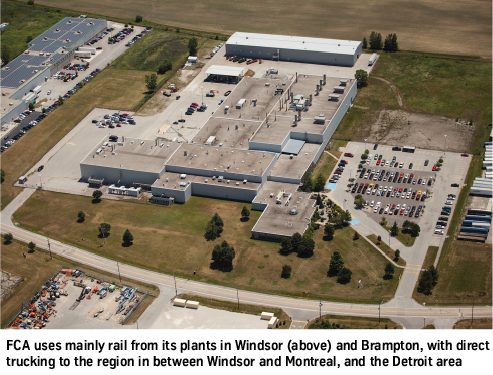 Nevertheless, logistics providers and carmakers have still noted capacity and velocity issues for railways in Canada. Steve Istvanov at Kia points to rail strikes that have caused transport disruption, for example. Bill Garrett at Vascor also points out that the growth in Mexico may be having negative impacts on Canada’s access to railcars in the common North American pool, as rising production in the south requires more empty equipment. The winter climate in Canada also makes it riskier to inspect vehicles because of ice on the equipment.
Nevertheless, logistics providers and carmakers have still noted capacity and velocity issues for railways in Canada. Steve Istvanov at Kia points to rail strikes that have caused transport disruption, for example. Bill Garrett at Vascor also points out that the growth in Mexico may be having negative impacts on Canada’s access to railcars in the common North American pool, as rising production in the south requires more empty equipment. The winter climate in Canada also makes it riskier to inspect vehicles because of ice on the equipment.
As with the rest of North America, the trend towards higher sales for trucks and SUVs over sedans has led to imbalances in the rail network’s fleet of bi-level versus tri-level equipment. “This change in demand has stressed the bi-level railcar supply, so we acquired ‘Multi-Max’ railcars, which are convertible from bi-level to tri-level. This flexible capacity is a growing percentage of our fleet,” says William Reichard, assistant vice-president of automotive at Canadian National.
Reichard adds that CN faces difficulties in the difference in operating schedules among parties. The railways, as well as Autoport, CN’s terminal at the port of Halifax, operate seven days per week, but other elements such as haulaway carriers and the dealerships may operate only five days per week.
Rail providers and carmakers have been responding with new ideas to improve the network. For example, Reichard says that CN is working with haulaway carriers to extend operating hours where feasible.
Nicole Methven, director of sales, autos, and transload at Canadian Pacific, says the railway has been able to increase velocity. “We achieved a 21% improvement in 2015 over 2014,” she says. She points out that CP has recently improved the airflow tests through its trains to ensure that brake pressure can be maintained through the cold winter months, something that had long been an issue.
Another way in which both Canadian railways have been able to reduce congestion has been by bypassing Chicago and instead routing traffic through Kansas City for both northbound and southbound moves. “We are seeing growth in finished vehicle volumes from Mexico stemming from increased production there. By routing from Kansas City, CP also reduces the handling of railcars by multiple rail carriers,” Methven says.
 For vehicles destined from Canada to the western US, this interchange saves about 48 hours, according to Vee Kachroo, vice-president of supply chain solutions at CN. He also points to projects that include working with railcar pool provider TTX Company to improve the reload network. Furthermore, Kachroo wants to focus on vehicle processing at multiple locations through CN’s processing subsidiary, Autoport. William Reichard adds that improving yard management processes and systems is also an important focus.
For vehicles destined from Canada to the western US, this interchange saves about 48 hours, according to Vee Kachroo, vice-president of supply chain solutions at CN. He also points to projects that include working with railcar pool provider TTX Company to improve the reload network. Furthermore, Kachroo wants to focus on vehicle processing at multiple locations through CN’s processing subsidiary, Autoport. William Reichard adds that improving yard management processes and systems is also an important focus.
Look for flexibility on the road
Despite its significant use of rail, road hauliers are a vital part of the Canadian vehicle distribution network, with a wide variety of carriers that include large, US-based players such as Jack Cooper Transport and United Road, which also have fleets in Canada, as well as a number of strong local players. L. Hansen’s Forwarding, based in Scarborough, Ontario, is Canada’s largest car hauler. Mike Hansen says that the company handled around 456,000 units in 2015 across a fleet of 215 trucks. About 90% of Hansen’s haulage volume is within Canada, however it also ships to the US.
Another Canadian road carrier is CCT Auto-Trans, based in Bowmanville, Ontario, which moves about 100,000 new vehicles each year. The company serves Ontario, Quebec, the Maritime Provinces, as well as parts of the US Midwest and north-east. Chad Doiron, CEO and secretary treasurer, says CCT specialises in cross-border haulaway volumes to dealerships and drop yards for further transport by truck, rail, or vessel. It also carries backhauls from the US to dealerships in Ontario.

Rail shortages and delays have created openings in Canada’s haulaway business. “One trend is that OEMs have increased the haulaway mileage circumference from 250 miles to 750 miles (400km to 1,200km),” says Doiron. “As [road-based] volumes continue to increase, more [trucking] equipment is the key to adding capacity in order to serve rail ramps.”
However, Canada’s long distance, low-density populations make it even more difficult to deliver profitably to northern and hinterland regions, as well as to islands on both coasts. Marna Short, general manager of national inspections at Vascor, says that for serving remote dealerships, two units that need to travel 500 miles more will require 12 hours more dwell time. “In Canada, the impact is felt greater than in the US, which has the ability to be more flexible,” she says.
Marc Brazeau also points to the difficult trade-off between shipping density and transit time. Although about 70% of FCA’s vehicle deliveries are within a 200-mile radius, some destinations are hundreds of miles away or more. While the carmaker has the same quality objectives for damage and on-time delivery in Canada as it does elsewhere, such targets require some nuanced approaches in Canada compared to in the US because of its geography. For example, Brazeau says that FCA emphasises the efficiency of vehicle handoffs between logistics providers in Canada. The OEM also identifies carriers with flexible equipment, such as flatbed towaways and stingers that hold just two or three vehicles, which allow carriers to haul different kinds of vehicles and equipment for return legs.
Hansen’s tries to overcome the low-density issue by combining different OEMs on the same truck (although it tries to ship single OEMs wherever possible to populous areas like Vancouver, Montreal and Toronto). Hansen points to current service levels that have reached 95%. Marc Brazeau says FCA is also combining different OEMs on the same trailer for remote destinations.
More broadly, Brazeau points to growing volumes by road and increasing competition among FCA’s carriers. “Our pipelines are fuller. As we reach the high end of record volumes, we will experience a capacity lag,” he predicts. In response, FCA is instituting more night and weekend deliveries.

Kia Canada offers an example of how an increasingly diverse transport mix can benefit carmakers in Canada. For 2015, Kia planned to ship more than 58,000 units to Canada from South Korea, and nearly 14,500 units from its plant in West Point, Georgia. The carmaker uses the port of Vancouver for Korean imports and ships by rail to Edmonton, Saskatoon, Winnipeg, Toronto, Montreal, Quebec City, and Halifax. Kia’s Steve Istvanov points to disruptions from rail strikes earlier in 2015 that led the OEM to change aspects of its network. “We dealt with it by using a multi-port, multi-carrier diversification approach that continues today,” he states.
Kia also ships by water within Canada via Oceanex, a ro-ro carrier that offers a service from Halifax to St. John’s in Newfoundland. This past winter, with Halifax frozen, the weather situation necessitated another option. Kia now uses Oceanex’s twice-weekly sailings from Montreal to St. John’s; the vessels are equipped with icebreaker capabilities to handle Canadian winters.
The changes in Canada’s vehicle production and sales mix, including a shift towards more imports in cases, could change the emphasis for vehicle logistics in some areas. For example, along with the large amount of rail flows FCA exchanges with the US and from Mexico, the carmaker also imports finished vehicles from Europe through the port of Halifax, and a small number through the port of Vancouver. Ocean imports are now on the rise for FCA as it brings in Fiat and Jeep products built in Europe. “As such, Halifax may become a bigger part of our ocean strategy,” says Marc Brazeau.
A similar dynamic may emerge in some ways for Kia, after a new plant opens in Mexico in May 2016. Though the OEM has not yet revealed its export strategy, vehicles could end up moving northbound by both rail and sea to Canada.
Patrick Lewis, director of business management at ICL Systems, which has important vehicle logistics management operations in Canada, including for FCA, predicts that the numbers of imports to Canada from the US, Mexico, and via the ports in Vancouver and Halifax, will increase whereas exports will decrease. “This has put more pressure on capacity at the destination auto facilities across Canada, since these facilities have not expanded their capacity,” he says.
Such developments will raise more questions about Canadian infrastructure, which critics say has been underfunded over recent years and decades. The emphasis on Canada’s transport network was reflected in its recent parliamentary elections, in which the victorious Liberal party and new prime minister, Justin Trudeau, promised to deploy C$125 billion ($93 billion) over ten years in federal spending for road, rail, bridges and ports. Trudeau has even said that he will run a budget deficit in part to fund this investment.
Though mature, the Canadian market remains a vibrant one, and is likely to see an array of different dynamics as production shifts, and imports within and beyond NAFTA rise. While macroeconomic factors and trade deals will drive many of these changes, remaining competitive and efficient for vehicle distribution will become more important both for export-orientated carmakers producing in Canada, as well as for the growing local market. The country’s natural conditions and geography may make this more difficult, but Canadian logistics and rail providers have proven resilient, innovative and collaborative. As Mexican production grows and Canada moves towards the TPP, they will need to be even more so.
































